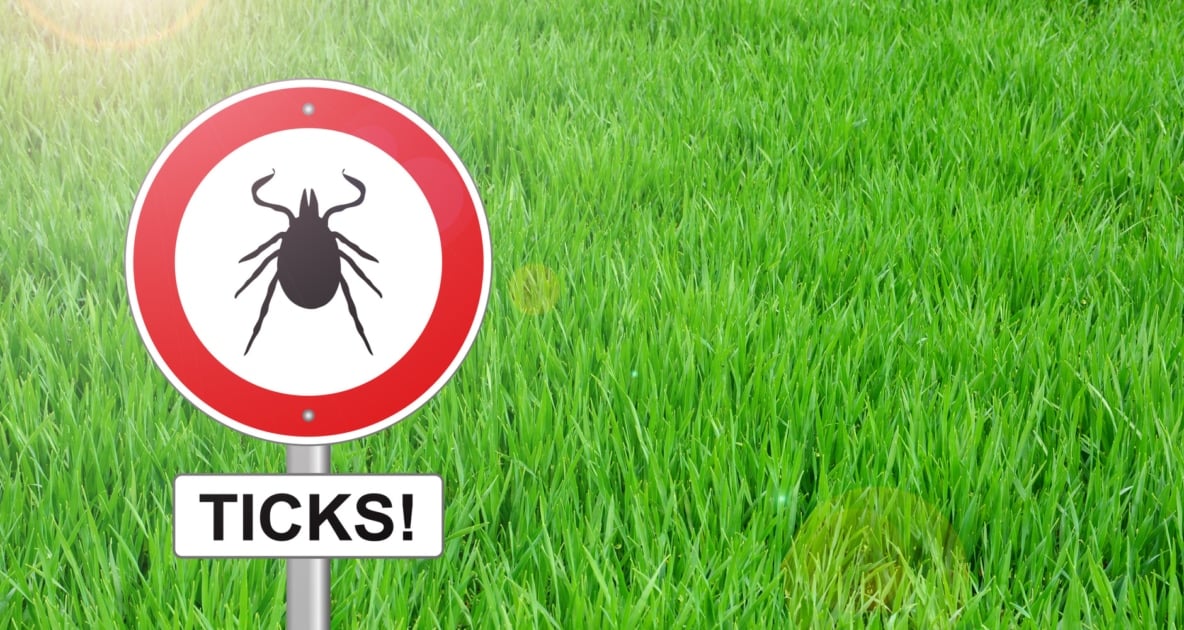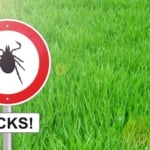7 Natural Tick Remedies That Work
Tick season is upon us. Try these natural and effective remedies and strategies to repel these nasty parasites without harmful chemicals.

Deer ticks and dog ticks are growing in numbers and concern. Not only are they a nuisance, they carry many dangerous illnesses including Lyme disease. According to the CDC there are over 300,000 estimated new cases of Lyme disease in the United States each year. Learn more facts and see our suggestions for effective natural tick repellents.
Different Types Of Ticks
There are many different types of ticks, each of which transmit different types of illnesses.
Ticks are categorized into two types: soft (Argasidae) and hard (Ixodiae) ticks. With roughly 700 types of hard ticks and 200 types of soft ticks, only around 60 of those species of ticks actually bite and transmit diseases. Here are some of the most common types:
- Deer tick (blacklegged tick) – Notorious for spreading Lyme disease and its co-infections. But the risk of developing these infections depends on several factors, including the type of tick and how long it was attached to the skin.
- Lone star tick
- American dog tick
- Brown dog tick
- Gulf coast tick
- Rocky Mountain tick
- Gulf Coast tick
- Pacific Coast tick
In the unfortunate event that you are bitten by a tick and become sick, being able to identify which type of tick you were bitten by will give you a better idea of type of illness was transmitted to you. It is always a good idea to save the tick after you have safely detached it, to properly identify it and provide your doctor with additional information.
Types Of Tick-Borne Illnesses
Common types of tick-borne illnesses include:
- Rocky Mountain spotted fever
- Powassan encephalitis
- Babesiosis
- Ehrlichiosis
- Anaplasmosis
- Tularemia
- Southern tick-associated Rash Illness
Tick Prevention
Prevention is the best way to avoid the devastating effects of Lyme disease and other tick-borne illnesses.
Wear light-colored long pants and sleeves whenever you are outside in tall grass, among a lot of trees, or where you know ticks like to hang out. Tuck in your shirt and pull your socks over your pants for added protection. When you return home immediately do a tick check, paying particular attention to folds of skin, such as your underarms and between the toes and hair. Look everywhere. Deer ticks are very tiny and may not be seen if you check too quickly. Finally, throw your clothes in a hot dryer and take a shower.
One of the best ways to reduce ticks on your property is to keep it well maintained. About 82% of ticks found on lawns are within nine feet of the lawn’s perimeter, particularly if your lawn borders woods, stone walls, or leafy plantings. Ticks also don’t like dry and sunny locations. To minimize tick exposure on your lawn, create a landscape with more sunny areas and clearly defined borders. Adding wood chips or gravel between your lawn and woods and removing dead leaves and overgrown shrubs along the lawn’s perimeter can help keep ticks at bay. Planting tick repellent plants, such as lavender, rosemary, and marigolds, particularly around the perimeter can help deter ticks from your lawn naturally. If possible, consider employing tick eaters. Chickens not only provide you with fresh eggs, they will peck aways at the ticks on your property. Guinea fowl are also great at eating ticks and rodents, while requiring little maintenance.
Natural Tick Repellents That Work
Here are some natural and effective tick repellents that will help keep those nasty parasites away without having to resort to harsh chemicals:
1) Apple Cider Vinegar
Apple cider vinegar to the rescue … once again! Apple Cider vinegar has an acidic taste that ticks hate.
The following solution can be sprayed on clothing and exposed skin—even lawn furniture: Combine two cups of water, four tablespoons of apple cider vinegar, and two tablespoons of organic neem oil. This spray works great on pets at controlling these menacing pests. Rub into pet’s fur after spraying. Be careful to avoid eyes, burns or damaged skin.
You may also make an apple cider vinegar spray with essential oils. Fill a spray bottle 1/3 of the way with apple cider vinegar. Then add 10 drops each of geranium, cedarwood, citronella, and lemongrass essential oils and fill the rest of the bottle with water. Shake well before spraying.
Ingesting Apple Cider Vinegar has also been known to repel ticks. Consider adding one teaspoon to your drinking water. (This method may even be safe for pets.)
2) Neem Oil
Neem oil is used as a natural remedy to repel and remove ticks. You may add several drops to the palm of your hand and rub on your exposed skin. However neem has a strong odor so many people choose to mask the scent by mixing it with almond or other light carrier oil. When diluted, it’s safe for dogs.
One common misconception is that you may apply a drop or two of neem oil directly on to a tick to remove one from you, but this is incorrect. Never put a substance directly to the tick if it is still attached to your skin. This may agitate the tick and cause it to force infected fluid into your skin. Only remove ticks with tweezers or a proper device, such as a tick key.
3) Aromatherapy Essential Oil Blend
Aromatherapy essential oils may smell great but they are also known to be natural tick repellents! Ticks hate the scent of lemon, orange, cinnamon, lavender, peppermint, and rose geranium so they’ll avoid latching on to anything that smells like those items. Any of these or a combination can be used in DIY sprays or added to almond oil and rubbed on exposed skin. We recommend using 100% certified organic essential oils in any of the above mixtures, which can be found online.
Note: Always dilute solutions before applying to your dog. For further reading on essential oils and dogs, check here. Essential oils are not recommended for use on cats. Please consult with your veterinarian about effective flea and tick control for cats.
Try this simple recipe. Just mix and apply to exposed skin before heading outdoors:
- Citronella essential oil (9 drops)
- Tea tree essential oil (6 drops)
- Peppermint essential oil (6 drops)
- Almond oil or jojoba oil (1 tablespoon)
4) Eucalyptus Oil
Eucalyptus oil is known as an effective tick repeller and killer. It also has a citrusy refreshing smell! Mix 4 ounces of purified or distilled water to a small spray bottle along with 20 drops of eucalyptus essential oil. (Note: Eucalyptus oil must be diluted before application.) Shake before using and spray on your skin, pant cuffs, and shoes. Diluted eucalyptus is also safe for use on dogs. You may soak your dog’s collar overnight and let it dry to help ward off ticks.
5) Cedar Oil Spray
Cedar oil is a non-toxic, natural tick and insect repellent. It can be sprayed directly on clothing and skin. It is safe for use on humans and pets. Not only does cedar oil repel ticks and other irritating insects, but it kills them. Cedar oil spray can be purchased online and at most pet stores and big-box retailers. You can also make your own! Mix four ounces of distilled or boiled water, witch hazel, and 30-50 drops of cedar oil in a spray bottle. Add lavender or vanilla for a sweet for an additional sweet smell. Cedar oil spray can be applied to clothes, skin, as well as on plants.
6) Oregano Oil
Oregano oil has been found to be an effective insect repellent. Dilute a few drops of oregano oil with 1 teaspoon of a carrier oil, such as coconut oil, argan oil, or almond oil and rub on your exposed skin. You can also use it as a spray, by adding 5-10 drops of water into one cup of water and spray onto skin. A little spray bottle is easy to pack along on a hike or trip to the park. Respray every hour.
7) Safe Tick Repellents for Dogs – Tap Here
What To Do If You See A Tick On You
If you find a tick attached to your skin, visit the Center for Disease Control’s Website for more information for tips to remove ticks safely and next steps. (Not all ticks carry Lyme disease but finding one can still be unsettling.)
If you see a tick crawling on your clothing, or if you have ventured into a known tick-infested area, you should do the following:
- Grab the lint roller (take it with you on outings!). A sticky tape lint roller is excellent for picking ticks of any size off your skin and clothing. Carry one with you and brush it over your skin and clothes (and pet’s fur) periodically.
- Toss your clothing into a hot dryer for 10 to 15 minutes to kill any lurking ticks.
- Do a full-body check on yourself, family members, and pets. Brush your hair and jump in the shower. Rinse pets using the outdoor hose before heading inside.
Join The Discussion
Have you ever found a tick on yourself or a family member?
What are your favorite tick repellents or methods for prevention?
Share with your community here in the comments below!
Related
Centers For Disease Control Website
Safe Insect Repellents For Dogs
7 Amazing Uses For Apple Cider Vinegar






Wow! There is some VERY bad information in these comments. It’s almost so bad, if I was the author of this article, I’d turn the comments off. Here’s some TRUTH for those that care to learn:
– Garlic is NOT toxic in small amounts to dogs.
– DAWN dish soap IS toxic to pets (I wrote the company and they said they don’t recommend using it on pets)
– The vet prescribed pills and spot treatments, including Bravecto have injured or killed THOUSANDS of dogs. Heck, Bravecto has injured so many pets, there’s a Facebook group with over 50k members discussing it. There are groups for the others as well. You are putting a toxic pesticide on an animal that goes into ALL of it’s organs and it still has to be bitten by a tick in order to kill it. THINK about that.
– Whenever any of my pets have ever had a tick, I just immediately pull the darn thing out, flush it down the toilet (if inside) or break it’s head off from its body, if I’m outside. No running around like an idiot trying to find tweezers or whatever, just get the stupid parasite off immediately. There is a tick-borne disease in cats called ‘Cytauxzoonosis’ or ‘Bobcat Fever’ that has a 60% fatality rate, so check your area for that (you or your dog can bring a carrier tick in, so even house cats can be exposed). Check pets daily during tick season and watch for any signs in your cat if you remove a tick from them and are in the area where that disease is found. There are important protocols that must be met for survival, so look into them and be prepared just in case.
– A healthy animal is less likely to have parasites. That’s a FACT. If your pet is covered in fleas and/or ticks, it’s probably because it’s not overly healthy, you are keeping your grass in your yard too tall, you aren’t vacuuming your house often enough, or a combination of all of those. Crappy food, over vaccination (do your research!! It’s a big pharma scam to make money and it sickens our pets) and prescription meds all take a toll on your pets health. Your pet may look healthy, but obviously, if parasites find them irresistable, there’s your sign. I have multiple indoor/outdoor country pets and have never had a flea problem. I’ve taken in pets over the years that showed up that had them (as well as ticks), but as soon as I put them on a good diet and limit their exposure to toxins of all kinds (including multiple vaccines and any pharmaceutical meds), they are healthy and flea-free until they get up into their teens. Ticks are minimal as well as worms of any kind.
Prescription meds killed my dog and when I researched it, I found that it had harmed or killed thousands of other dogs and my vet conveniently never warned me that death was a possible side effect. It turns out, they RARELY do, no matter what they prescribe, including those seemingly harmless flea/tick meds and MANY others including pain meds and injections for itchiness and stuff. Only about 1% of those negative reactions/deaths even get reported because people don’t know to or realize it was the pill/treatment they just gave a few days or a week ago that killed/injured their pet.
My advice, if you are a pet owner, stop running to the vet for every little thing. There are a TON of things you can do to treat and protect yourself and your pets without using dangerous products, but you’ll actually have to do a little research. And here’s a good tip. BEFORE you put anything on or in your pet, do a search for “_______ killed my cat/dog” and see how many results pop up. That includes food like Blue Buffalo, Purina, etc. One death is too many for me after watching my perfectly healthy dog who only suffered from arthritis die a slow and painful death.
The regurgitation of “Garlic is deadly!” and “I use DAWN dish soap” information has to stop. It’s quick and easy to do a search and verify if what some yahoo on the internet said is true. Use your own discernment. And for the love of cake, DO SOME RESEARCH, join a group on Facebook, buy a book, etc. Educate yourself. Your family and your pet is worth it.
Are labradors prone to ticks ?
Tea Tree oil is highly toxic to pets
HI I need to use a tick repellant on my composite deck, what do you recommend? I have vegetation on it in containers and lots of birds because we are alongside a hydro line. I want rid of the ticks, but not destroy my composite decking
I think it was pubmed I was reading today, if not, a similar authority, which said 30% essential oil to water, and you MUST add glycerin bc oil and water don’t mix. Nor do oil and vinegar. Glycerin acts as an emulsifier.
How much glycerin?
I spray my yard with half water and half hartz mtn flea and tick shampoo. Works great
Does this do anything to harm the lawn or plants that it gets on?
Hartz is VERY dangerous. all store bought are dangerous. Use Cedar oil diluted with water..spray yard. …
concerned about ticks when hiking, don’t want to use chemicals. Your suggestions are great.
Hi Kathy, we’re glad you found the information helpful. Be sure to do a thorough tick check after every outing.
The CDC doesn’t recognize Lyme disease as an actual thing. It suggests a few weeks of antibiotics which is much shorter than the 30 day life cycle of the spirochete, leaving some people thinking they are free and in the clear from getting lyme , only to end of with a myriad of unexplainable health issues, many which mimic some of the severe longterm affects of covid 19–brain fog, fatigue, various organ issues ect. Tic bites can infect you within 10 minutes. Take optimal care when going in the woods
WTH, yes it does! But “chronic Lyme” is woo. A tiny minority of patients may have Post Treatment Lyme (PTLD) but not this lifelong infection that quack “Lyme Literate Doctors” peddle. People who test negative for Lyme and don’t live in areas with these ticks or the endemic disease are not infected yet these bloodsucking naturopaths, homeopaths and other unqualified hacks are “diagnosing” them with Lyme and prescribing drugs that increase bacterial resistance in the general population and can cause serious problems of their own. It’s a racket.
Lyme and Chronic Lyme is very real! Most physicians are not educated on this disease and if they are they do not want to get involved! They are bound by the CDC and IDSA guidelines to only treat for 14-28 days. The testing methods are also outdated and NOT reliable. The doctors who do treat aggressively are told they will loose their license if they do so! There is a very good reason why the Lyme Literate Doctors can not take insurance. They will properly treat the disease and save a person a lifetime of deteriorating health issues caused by ticks. People just don’t get it until they get it! It’s a horrible disease!
I have pure peppermint oil. Can I mix with water and spray on my clothing..if so what is the ratio of water to peppermint oil
As far as consuming garlic as a repellant,do you know of any recommendations for how much to consume?
Hi Robert, just a meal with garlic should be helpful. Cook up some scampi!
Lots of good authentic Italian food
Yes! Garlic!